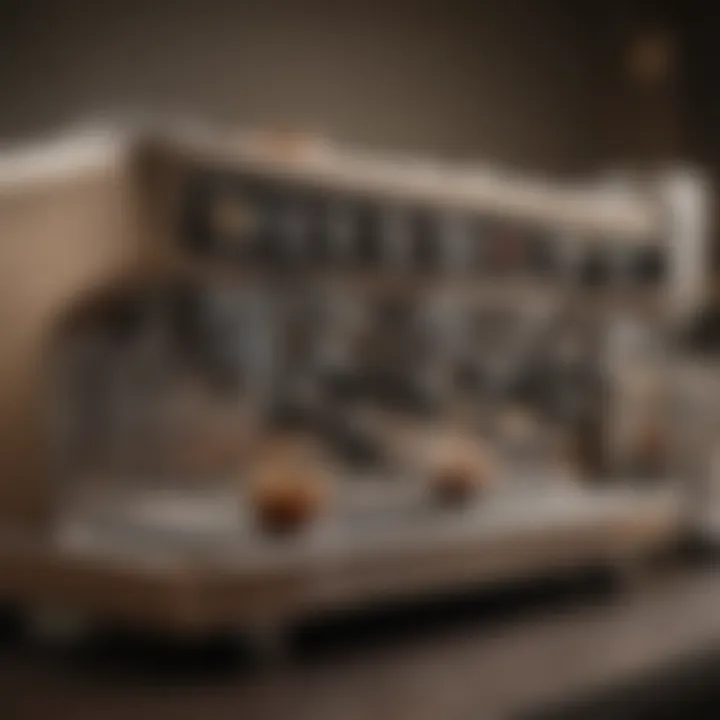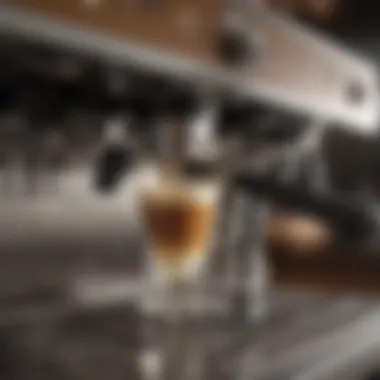The Ultimate Guide to Espresso Devices: Types & Tips


Intro
Espresso devices are pivotal in the world of coffee, transforming mere beans into a rich and aromatic beverage that captivates many. Understanding these devices can significantly enhance both the crafting and enjoyment of espresso. This guide will shed light on various aspects of espresso machines, from their fundamental types to the intricate art of maintenance. The ultimate goal is to equip both novices and seasoned enthusiasts with crucial knowledge to appreciate and select the right machine for their needs.
As the realm of espresso continues to evolve, so do the devices. Integration of technology and user preferences play vital roles in shaping modern espresso brewing. By exploring these developments, readers can better grasp the nuances that impact espresso quality.
Prelims to Espresso Devices
Espresso machines are more than just devices; they are gateways to a rich world of coffee culture. Understanding espresso devices is crucial for both casual drinkers and aficionados. The structure, components, and history of these machines can significantly impact the quality of the espresso produced. This section will delve into the definition and historical context of espresso devices, offering readers both a foundation and appreciation for this essential tool in coffee making.
Definition and Purpose
Espresso devices are specialized machines designed to brew concentrated coffee by forcing hot water through finely-ground coffee beans. The primary purpose of these devices is to achieve a strong, rich flavor profile that is characteristic of high-quality espresso. They offer diverse brewing styles, from the hands-on approach of manual machines to the ease of super-automatic options.
The purpose extends beyond just making coffee. Espresso machines play an important role in the experience of coffee drinking. They can enhance the aroma, texture, and overall quality of the beverage.
Historical Context
The journey of espresso devices began in the early 20th century. In 1901, Luigi Bezzera patented the first espresso machine, which set the stage for future innovations. Over the decades, these machines have evolved significantly, moving from steam-driven models to the sophisticated devices we see today.
In Italy, espresso became a cultural staple, influencing social gatherings and dining habits. Each development in technology not only improved the functionality of the machines but also altered the way people experienced coffee. For instance, the introduction of the portafilter added precision to coffee brewing, allowing a consistent quality across different servings.
Today, espresso devices are available in various forms, catering to different preferences and lifestyles. From compact home units to commercial giants, each design reflects the ongoing evolution of coffee culture.
Types of Espresso Machines
The realm of espresso machines is diverse, with each type offering unique features and capabilities. Understanding the different kinds of espresso machines is vital for anyone looking to invest in one. This section explores the key types, offering insights into their advantages, considerations, and ideal usage scenarios. This knowledge can significantly impact your espresso experience, from preparation style to the quality of the final brew.
Manual Espresso Machines
Manual espresso machines, often referred to as hand-operated machines, give the barista full control over the brewing process. They require the user to manually exert pressure to extract espresso. This can involve using a lever or other mechanism to generate pressure.
Benefits:
- Control Over Extraction: Users can adjust various aspects like pressure and timing for personalized results.
- Skill Development: Users develop a deeper understanding of espresso-making.
- Compact Design: They are often smaller and more portable, suitable for tight spaces.
Considerations:
- Learning Curve: Requires more practice and skill.
- Physical Effort: Can be tiring for some users.
Semi-Automatic Machines
Semi-automatic machines combine manual techniques with electronic control. The machine controls water flow, while the user manages the grinding and tamping of coffee.
Benefits:
- Balance of Control and Convenience: They allow for some degree of manual control while simplifying certain processes.
- Consistent Results: Automated features help maintain quality across brews.
- Versatile Use: Suitable for both beginners and experienced users.
Considerations:
- Requires knowledge of tamping and grinds.
- Maintenance has to be done regularly for optimal performance.
Automatic and Super-Automatic Machines
Automatic and super-automatic machines take convenience to the next level. They are designed to handle almost every aspect of the espresso-making process, from grinding the beans to steaming milk.
Benefits:
- Convenience: Especially helpful for those short on time or those who want consistent coffee without the effort.
- All-in-One: No need for separate grinders or kettles, as everything is integrated.
- Customizable Settings: Many models allow users to adjust settings like strength and temperature.
Considerations:
- Less control over extraction compared to manual options.
- Generally more expensive due to advanced technology.
Lever Espresso Machines
Lever machines are a classic option, often chosen for their traditional design and manual operation. These machines primarily rely on a lever to generate the necessary pressure during extraction.
Benefits:
- True Barista Experience: Aimed at purists who appreciate the craft.
- Minimal Electronics: Offers reliability and longevity, with fewer parts that can fail.
- Aesthetically Pleasing: Often have vintage designs that appeal to enthusiasts.
Considerations:
- Demands skill and expertise to master.
- Not for those wanting speed and convenience.


"Choosing the right espresso machine is not just about the coffee; it's about the experience you wish to create each time you brew."
In summary, each type of espresso machine caters to different user preferences and skill levels. Understanding these variations can guide you toward selecting the ideal machine for your coffee needs.
Key Components of Espresso Devices
Understanding the key components of espresso devices is essential for both new and seasoned users. These components play a crucial role in the functionality and performance of espresso machines. Each element contributes to the brewing process, affecting the quality of the espresso produced. Proper knowledge of these components can lead to better espresso preparation and appreciation.
Group Head
The group head is arguably the heart of any espresso machine. It is where the magic happens, as this is the part that holds the portafilter in place and directs hot water through the coffee grounds. The group head's temperature stability is critical for achieving consistent extraction. If the temperature fluctuates, it can lead to variations in flavor, impacting the overall experience.
Proper maintenance of the group head ensures longevity and performance. Regular cleaning prevents coffee oils and residue buildup, which can sour the taste of future shots. Using a backflush technique with a blind filter basket helps keep the group head clean and free from obstructions.
Boiler and Heating System
The boiler is responsible for heating water to the precise temperatures required for espresso extraction. Different types of boilers exist, such as single, double, and heat exchange systems. Each type has its advantages and disadvantages.
- Single Boiler: Offers simplicity and reliability, but can only brew or steam at one time.
- Double Boiler: Allows simultaneous brewing and steaming, providing greater flexibility and efficiency.
- Heat Exchange: Heats water for brewing while also maintaining a steam temperature.
Temperature plays a significant role in espresso quality. The water should ideally be around 90 to 95 degrees Celsius during extraction. An inconsistent heating system can result in flawed shots. Regular descaling is necessary to prevent mineral buildup in the boiler, which can affect both function and flavor.
Portafilter
The portafilter is the component that holds the coffee grounds and attaches to the group head. It comes in different styles, such as single, double, and bottomless. Each variant has unique features that can impact the brewing process.
Using a well-designed portafilter is essential. A bottomless portafilter, for example, can expose flaws in the grind size or extraction technique, providing instant feedback for improvement. The material of the portafilter, often stainless steel, also affects heat retention and overall durability.
Cleaning the portafilter is just as crucial. After each use, it should be rinsed and scrubbed to maintain its performance and taste integrity. A well-maintained portafilter can significantly enhance the brewing process.
Steam Wand
The steam wand is vital for creating frothed milk for various espresso-based beverages. It allows users to steam and foam milk, which is essential for drinks like cappuccinos and lattes. The quality of the steam wand affects the microfoam's texture and consistency, an important aspect for latte art and overall drink quality.
A steam wand's design can vary, affecting user experience. A double-position wand, for example, offers more flexibility in frothing techniques. Users also need to understand the proper steaming technique, ensuring that the milk reaches the right temperature and texture. Keeping the steam wand clean is critical; it should be wiped down after each use to prevent milk residue buildup, which can affect future frothing.
"Understanding the components of espresso machines leads to better preparation and appreciation of this beloved beverage."
In summary, each component of an espresso device has its importance and functionality. By maintaining and understanding these key parts, users can significantly enhance their espresso-making experience. A thorough grasp of these elements prepares one not only for better espresso but also fosters a deeper appreciation for the craft.
Factors Impacting Espresso Quality
The quality of espresso hinges on several critical factors. Understanding these elements is essential for anyone looking to brew a superior cup. Each factor interacts with the others, creating a complex interplay that determines the final taste and experience.
Grind Size and Consistency
Grind size plays a pivotal role in espresso quality. When coffee beans are ground, the surface area that is exposed to water increases. A finer grind allows for more extraction from the coffee, while a coarser grind results in less extraction. This balance is crucial.
Consistency in grind size is equally important. Uneven grounds can lead to various extraction levels in a single shot. Some coffee grounds might over-extract, leading to bitterness, while others may under-extract, resulting in a sour taste. Investing in a good burr grinder can ensure that the coffee is consistently ground to the desired size. Typically, a fine grind resembling table salt works best for espresso.
Water Temperature and Quality
Water acts as the medium for extraction, making its quality and temperature integral to espresso preparation. The ideal brewing temperature for espresso typically ranges from 90 to 96 degrees Celsius (194 to 205 degrees Fahrenheit). If the water is too hot, it can scorch the coffee, altering its flavor profile negatively. Conversely, water that is too cool will not extract the flavors adequately.
Furthermore, the quality of water used can greatly affect the taste. Water with high mineral content can enhance flavor, while water with impurities can impart off-flavors. Relying on filtered water is recommended for achieving the best results. Regular maintenance of espresso machines is also necessary to ensure the water quality remains optimal.
Pressure and Extraction Time
Pressure and extraction time are interconnected factors that must be managed carefully. The standard pressure for espresso extraction is around 9 bars. This pressure extracts oils and flavors effectively, leading to a rich crema - that golden layer on top of the shot.
Extraction time generally ranges from 25 to 30 seconds. If extraction time is too short, the coffee may taste weak, lacking the depth of flavor that espresso is known for. Conversely, if the extraction takes too long, it can lead to over-extraction, imparting a bitter taste. Adjusting both pressure and time can drastically alter the espresso's characteristics, and thus finding the right balance is essential for producing a high-quality brew.
"The magic of espresso lies in the harmonious interaction of all these factors. Mastery requires both science and art."
By understanding these elements, anyone can improve their espresso-making skills significantly.
Choosing the Right Espresso Device
Selecting the appropriate espresso device is a pivotal step for anyone interested in brewing quality espresso at home or in a café setting. The right machine can significantly enhance user experience and the quality of espresso produced. It caters not only to individual preferences but also accommodates varying skill levels and budget constraints. Understanding your specific needs helps streamline the decision-making process.
Identifying User Needs
The first consideration when choosing an espresso device is identifying user needs. Each user has different requirements based on factors such as experience, volume of coffee prepared, and desired flavors. For example, a novice might prefer a semi-automatic machine that balances control with simplicity, while a seasoned barista may seek a fully manual machine for increased precision.
Moreover, some users may prioritize compact designs suitable for small kitchens, while others may require larger machines with advanced features for high-volume brewing. Questions to reflect on include:
- How often will the espresso machine be used?
- Is portability a factor?
- Are specific brewing techniques preferred?


By analyzing these aspects, users can match their expectations with the machine's capabilities. Focusing on user needs ensures the chosen device enhances the overall brewing experience and satisfaction.
Budget Considerations
Budget is a critical factor in the selection process, influencing both the type of espresso device and the quality of espresso it can produce. Espresso machines vary widely in price, with entry-level models costing a few hundred dollars and high-end commercial machines exceeding several thousand.
To effectively navigate budget considerations:
- Determine a Realistic Price Range: Evaluate how much you are willing to spend. This informs which features may be within reach.
- Consider Long-term Value: Sometimes higher initial costs lead to better durability and longevity. Investing in a well-built machine can pay off over time.
- Include Additional Expenses: Account for accessories such as grinders, tampers, and maintenance. These factors play a role in the total cost of ownership and should not be overlooked.
Setting a clear budget helps refine choices and protects against overspending on features that may not be necessary.
Brand Reputation and Reviews
Brand reputation is often a key indicator of a machine's reliability and overall performance. Established brands with a long history in the industry tend to offer quality assurance and customer support. Researching user reviews and expert opinions facilitates informed decisions.
When assessing brands, consider the following:
- Warranty and Support: A strong warranty reflects confidence in the product's quality. Good customer service is essential for any issues that may arise.
- User Feedback: Reading user reviews on platforms like Reddit or Facebook can provide practical insights into the machine's performance in real-life settings.
- Expert Recommendations: Articles and resources on websites such as Wikipedia or Britannica might indicate trusted brands recognized for innovation and craftsmanship.
Acquiring a machine from a reputable brand often results in better performance and a more satisfying espresso experience. Users are encouraged to gather diverse perspectives to ensure a well-rounded view before making the purchase.
Maintenance and Care of Espresso Machines
Proper maintenance and care for espresso machines is crucial for longevity and optimal performance. Regular upkeep not only ensures that the machine runs efficiently but also guarantees high-quality espresso. Dirty machines can lead to inconsistencies in flavor and quality of the brew. Furthermore, with various components interacting, lack of cleaning can cause clogs or wear and tear on essential parts. Investing time in maintenance pays off in the long run, both in the quality of espresso and in reducing repair costs.
Daily Cleaning Routines
Daily cleaning is essential for any espresso machine, irrespective of the level of sophistication. This routine typically involves a few critical steps:
- Backflushing the Group Head: This process removes coffee oils and residue. A blind filter basket is used for this. Regular backflushing will enhance the flavor and reduce bitterness in your espresso.
- Cleaning the Portafilter: Rinsing the portafilter right after brewing helps to prevent buildup. It's important to ensure there are no coffee grounds left trapped.
- Wiping Down Surfaces: The espresso machine should be wiped down after each use. This prevents stains and build-up of coffee oils. A damp cloth is suitable for this task.
A diligent cleaning routine ensures that machine longevity is maintained, and the brewing environment stays sanitary, promoting better overall taste.
Descaling Processes
Descaling removes mineral build-up within the espresso machine caused by hard water. This is crucial because mineral deposits can obstruct the water flow and affect the brewing temperature.
- Frequency of Descaling: Generally, descaling should occur every 1 to 3 months, depending on water hardness and frequency of use.
- Descaling Products: There are specific descaling solutions designed for espresso machines. Solutions like Dezcal or citric acid can effectively tackle the scaling issues.
- Descaling Procedure: Follow the manufacturer's instructions for descaling. Typically, it involves mixing the descaling solution with water, running it through the machine, and then following up with plain water to flush out any residue.
Regular descaling not only enhances the machine’s performance but also prolongs its lifespan, allowing for consistently great tasting espresso.
Replacing Parts
Over time, parts of an espresso machine will wear out and need replacement. Common parts that may require replacement include:
- Gaskets: These seals ensure a proper fit between various components. A worn gasket can lead to leaks and pressure issues.
- Water Filters: These need changing based on the type of filter used and water conditions. Clean water is essential for espresso quality.
- Heating Elements and Boilers: These are critical to the machine's operation. Signs of malfunction include inconsistent brewing temperatures.
When replacing parts, it’s crucial to ensure compatibility with your specific machine model. Using original components can greatly improve performance and ensure that any warranties remain valid.
Brewing the Perfect Espresso
Brewing the perfect espresso is essential for any coffee enthusiast or barista. This process significantly influences the overall taste and quality of espresso. A well-brewed shot reveals intricate flavors, rich aromas, and a pleasant mouthfeel. Understanding the nuances of brewing allows enthusiasts to interpret the coffee’s character, promoting a rewarding drinking experience. Each element in the brewing process plays a vital role in crafting an espresso shot that aligns with preferences. The following sections delve into the specifics of bean selection, techniques for pulling shots, and tasting and evaluation methodologies, offering a comprehensive view on how to achieve espresso excellence.
Bean Selection
The choice of beans is paramount when brewing espresso. Different coffee varieties impart distinct flavors. Arabica beans are generally preferred for their sweeter, more complex taste profiles. In contrast, Robusta beans offer a stronger, more bitter flavor, often used for blends. When selecting beans, consider factors such as origin, roast level, and freshness.
- Origin: Beans from different regions carry unique flavor notes. For example, Ethiopian beans are known for berry-like flavors, while Brazilian beans tend to be nuttier.
- Roast Level: The roast affects the acidity and body of the coffee. Darker roasts produce bolder flavors but may lose some of the beans' inherent complexity.
- Freshness: Freshly roasted beans yield better results. Aim to use beans within two weeks of roasting to capture optimal flavor.
"The journey to a perfect espresso starts long before brewing; it begins with choosing the right beans."
Techniques for Pulling Shots
Pulling shots is an art that requires precision and practice. The following are key elements to consider:
- Dose: Measure the coffee grounds accurately. A standard dose is about 18 to 20 grams for a double shot. Adjusting the dose can affect both extraction and flavor intensity.
- Tamp Pressure: Tamping compresses the coffee grounds evenly in the portafilter. It is crucial to apply consistent pressure, usually around 30 pounds, to achieve uniform extraction.
- Timing: The extraction time should generally be between 25 to 30 seconds. Monitoring this can help prevent over-extraction, which leads to bitterness.
Using these techniques efficiently lays the foundation for a balanced and flavorful espresso. Consistent practice leads to improved results and an understanding of how various factors influence the final taste.
Tasting and Evaluation
Evaluating espresso can enhance the brewing process. It allows drinkers to appreciate the subtleties in flavor and texture.
- Observe: Look for a rich crema on top of the shot. This indicates a well-pulled espresso. The crema can signal freshness and quality.
- Smell: Aroma contributes significantly to the sensory experience. Inhale deeply to recognize different notes that indicate the beans’ variety.
- Taste: Sip slowly, allowing the flavors to unfold on the palate. Identify sweetness, acidity, bitterness, and body. Each aspect plays a role in the overall experience.
- Evaluate: Compare each cup against your standards. Consistent evaluation helps refine brewing techniques.


Overall, brewing the perfect espresso involves a combination of careful choice of ingredients, precise techniques, and thoughtful evaluation. Mastering these elements can turn a simple cup of coffee into a remarkable experience.
Innovations in Espresso Devices
In the realm of espresso preparation, innovations play a crucial role in enhancing user experience and espresso quality. As technology advances, so too do the methods and devices used by coffee enthusiasts and professionals alike. Understanding these innovations can aid users in selecting the right devices to meet their requirements while optimizing the espresso brewing process. Innovations are not only about convenience; they also contribute to the precision, consistency, and overall enjoyment of espresso.
Technology Integration
Today, the integration of technology in espresso devices has transformed how coffee is made. Smart appliances are now commonplace, allowing users to control various aspects of brewing from their smartphones. For instance, temperature and pressure can be monitored and adjusted, leading to a more tailored espresso experience.
- Precision: Automated controls ensure that each shot is brewed under optimal conditions, improving flavor extraction.
- Customization: Users can select different recipes and settings for different bean types, enhancing the versatility of their machines.
- Monitoring: Many devices offer real-time feedback through apps, enabling users to adjust their processes on the fly.
"The rise of smart technology in espresso machines mirrors a broader trend toward automation and connectivity across many consumer goods."
Integrating technology also streamlines maintenance and troubleshooting. Some machines can self-diagnose issues and guide users through the necessary steps to resolve them. This focus on usability reflects a shift toward user-friendly products that require less specialized knowledge.
Smart Espresso Machines
Smart espresso machines epitomize many of these innovations. Brands are introducing devices that can connect to Wi-Fi and integrate with home automation systems. This connectivity provides several key benefits:
- Remote Operation: Users can start brewing from anywhere within their home, allowing for a seamless morning routine.
- Recipe Management: These machines often feature built-in databases of coffee recipes, which provide users with guidance on creating various types of drinks.
- Maintenance Alerts: Notifications about cleaning cycles, maintenance needs, and even espresso quality help keep the machine in peak condition.
Purchasing a smart espresso machine can seem daunting due to the number of available options. Nonetheless, focusing on essential features can make this decision easier. Look for machines that offer easy integration with your existing smart home setup, as well as customizable brewing options.
The future of espresso devices is undoubtedly intertwined with technological advancements. As consumers become more tech-savvy, the espresso industry is likely to keep evolving, catering to a growing demand for convenience, consistency, and perfection in every cup.
Cultural Significance of Espresso
Espresso is more than a beverage; it is a symbol of culture and tradition, particularly in Italy. Understanding the cultural significance of espresso elaborates not only on its origins but also on its impact on social interactions and daily life. In this section, we will explore how espresso is interwoven into the fabric of Italian society and how it has influenced global trends in coffee consumption.
Espresso in Italian Culture
Espresso serves as the backbone of Italian coffee culture. The ritual of brewing and consuming espresso is deeply ingrained in daily life. A common morning routine for many Italians begins at the bar, where they savor their espresso while engaging in conversations. This experience fosters social connections and strengthens community ties. Various espresso drinks, such as cappuccino and macchiato, also reflect regional preferences and play a role in the diverse Italian lifestyle.
Espresso's appeal is not limited to its strong flavor. It is often seen as an affirmation of craftsmanship and tradition. Italian baristas, known as "baristi", take pride in their skills. They can often identify the right balance of taste and texture. This expertise highlights the importance of proper technique, from grinding the beans to pulling the perfect shot. Through this lens, espresso cultivates a rich cultural narrative, making each cup a story of tradition and labor.
Global Espresso Trends
As espresso features prominently in Italian culture, its influence has spread globally. Different countries have adapted the concept of espresso, tailoring it to their local tastes and customs. Cities like Melbourne and New York have become espresso hubs, creating specialized coffee shops that elevate the coffee-drinking experience. Here, the emphasis is on quality and innovation, attracting enthusiasts and casual drinkers alike.
Another notable trend is the rise of specialty coffee and cold brew variations. Consumers now seek unique flavor profiles and sustainable sourcing, reflecting their growing awareness of the coffee supply chain. In countries like Japan and Sweden, innovative brewing methods blend with traditional techniques, creating new espresso experiences that shock the palate.
"Espresso is not just a drink; it represents a gathering place, a social ritual, and a connection to the past."
Espresso education has also gained momentum, with a focus on barista training and coffee knowledge. Events such as the World Barista Championship showcase talents from around the world, emphasizing the artistry involved in espresso making. This has led to a community where coffee lovers can share experiences, thus perpetuating espresso as a global phenomenon.
Common Mistakes in Espresso Preparation
Understanding common mistakes in espresso preparation is crucial for anyone seeking to master this art. Poor technique can lead to a failure to extract the full potential of coffee beans, resulting in a less than optimal espresso shot. By learning about these errors, individuals can improve their brewing methods, enhance flavor profiles, and ultimately achieve a more satisfying cup. This section examines two prominent mistakes: over-extraction and under-extraction, as well as incorrect grind size.
Over-extraction and Under-extraction
Over-extraction occurs when the coffee grounds release too many compounds into the espresso, often leading to a bitter taste. This happens when the brewing process is too long or when the water used is at a higher temperature than recommended. In contrast, under-extraction is the result of insufficient time or too low a temperature, resulting in a weak, sour, or overly acidic shot. Finding the right balance between these extremes is essential for creating an espresso that is rich, smooth, and full of flavor.
Tip: A standard brewing time for espresso is approximately 25 to 30 seconds. Experimenting with this timing can help achieve the desired richness and complexity in flavor. Additionally, monitor the water temperature, ideally keeping it between 90 to 96 degrees Celsius during extraction.
Incorrect Grind Size
Grind size is another critical factor affecting espresso quality. An incorrect grind can cause either over-extraction or under-extraction. Coffee that is ground too fine can lead to clogs and prolonged extraction times, while coffee that is too coarse will yield a quick, insufficient extraction. This inconsistency directly influences the espresso's flavor profile.
Optimal Grind Size: Aim for a fine, even grind similar to table salt. This consistency allows for even water contact during brewing, promoting the balanced extraction of flavors.
"The grind is just as important as the brew time; both must work in harmony to create the perfect espresso."
By being mindful of these common mistakes, one can refine their espresso-making skills. Whether grappling with extraction issues or grappling with grind size, awareness is the first step to creating exceptional espresso.
Future of Espresso Devices
The future of espresso devices is an essential subject in this article. As consumer demands evolve, so do the tools and technologies within the espresso landscape. Understanding the trajectory of these devices relies on multiple factors, including consumer preferences, sustainability practices, and technological advancements. The innovations happening in this sector not only enhance the brewing process but also address broader societal trends toward automation and eco-consciousness.
Evolving Consumer Preferences
In recent years, the preferences of espresso consumers have shifted significantly. More individuals today are looking for convenience and efficiency without compromising on quality. This trend leads to a rise in the demand for both automatic and super-automatic machines that reduce the complexity for users but still deliver a rich and satisfying espresso experience.
Additionally, many consumers are becoming more knowledgeable about coffee. They seek devices that allow for customization in brewing variables—such as grind size, water temperature, and pressure—enabling them to refine their personal coffee taste. This educated consumer base is not just looking for espresso machines but devices that facilitate a deeper connection with the brewing process.
"The shift towards personalization in coffee brewing reflects broader trends in consumer behavior. People want their appliances not only to work well but to resonate with their identity and values."
Impact of Sustainability
Sustainability is another pivotal aspect regarding the future of espresso devices. As awareness of environmental issues grows, consumers search for solutions that lessen their ecological footprint. Many manufacturers are now focusing on creating machines that consume less energy and utilize materials that are recyclable or sourced sustainably.
Another facet of sustainability involves the coffee itself. There's a trend toward sourcing beans from sustainable farms. Devices that facilitate this choice, such as machines designed to properly extract flavors from ethically sourced beans, are becoming increasingly popular.







